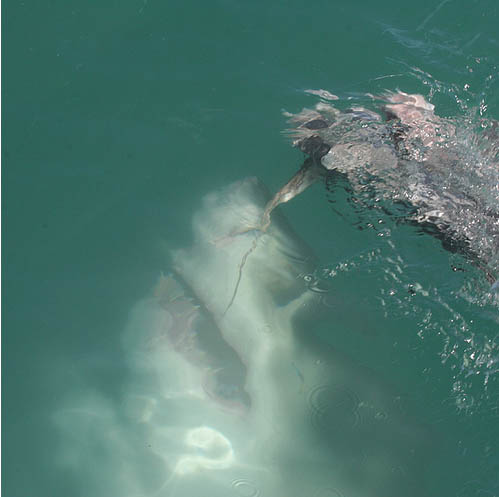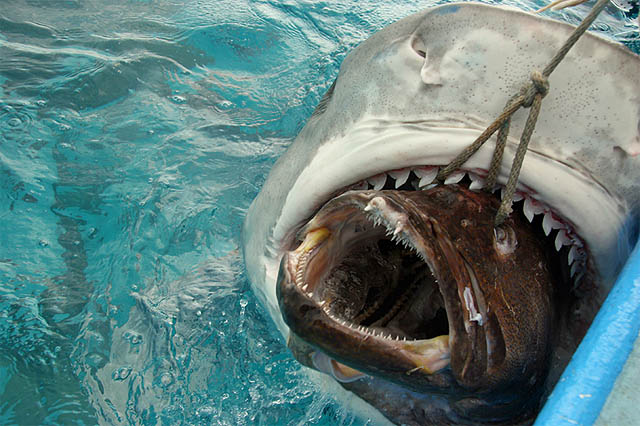
(image credit: Sue Hickton)
Such images lend themselves very well to Photoshop:
These sharks have reputation as vicious predators, yet they are not unsystematic "eating machines". They attack from below in order to investigate what is floating on the surface.
(image via)
(image via)
(image credit: David Doubilet, National Geographic)
Great white sharks not only swim, they FLY! 

See more pictures of the amazing hunt of great white sharks for seals in False Bay here.
(image credit: Eric Cheng)
This is definitely going to increase your confidence at sea: the enormous monster breaching the waves and flying at you with bloody dripping jaws. OK, it may not happen with such vivid color, but still....
(image credit: Lars-Gunnar Svard)
The Tiger shark is the fourth largest predatory shark. This shark is a solitary hunter, usually hunting at night. Its name is derivative from the dark stripes down its body, which grow fainter as the shark matures. It is infamous for attacks on swimmers, divers and surfers in Hawaii and is often referred to as "the wastebasket of the sea".
(image credit: Lars Kirchhoff)
Make way! The Boss is coming -
(image credit: Christie Fisher)
The tiger shark with a little "afternoon snack" -
(image credit: Christie Fisher)
Bull sharks often cruise through shallow waters and can suddenly burst into speed and can be highly aggressive. They are extremely territorial and will attack other animals and humans that enter their territory. Bull sharks are among the four species considered to be most dangerous to humans.
(images by wiki and Joe)
Here is a bit more aggressive photography:
(images via)
The first image shows the Shortfin Mako shark, one of the species that's officially responsible for eight unprovoked attacks on humans with two ending in fatality and twenty boat attacks.
In terms of size though, even the largest shark found on Earth today looks simply microscopic, compared to the size of prehistoric monsters, such as this Liopleurodon:
(image credit: Mark Witton)
Note that close to Liopleurodon's mouth is not a shark, but a huge plesiosaur, in itself the size of medium boat.
A few amazing facts about sharks: - via
- A shark does not have one bone in its body. Its skeleton is made up of cartilage. Cartilage is a tough material, like the material that shapes your ear.
- The Swell Shark, found in New Zealand, barks like a dog.
- Weird things have been found inside a shark, such as a bottle of wine, a treasure chest, a suit of armor, a drum and a torpedo.
- A shark’s skin is covered with denticles, which are small, razor-sharp teeth.
Not all huge sharks live in the warm or tropical waters. There is a shark species (still in many ways a mystery to biologists) that lives deep in the Artic water - sometimes as deep as 600 meters:
Greenland Sharks Lurk Beneath the Arctic Ice
The sleeper shark.... the "gurry" shark: the largest of Greenland sharks are comparable in size with the great white shark, although there is no record of them ever attacking humans. Check out these teeth though: small but razor-sharp -
(images by Nick Caloyianis National Geographic, and Canadian Shark Research Lab)
"Forget the cold. I kicked my fins and swam toward the shadowy figure. It turned and began moving toward me. I was face-to-face with a Greenland shark. I’d seen drawings and paintings of the fish, but this was utterly different. It was ghoulish. Its nostrils were the largest I had ever seen on a shark. They reminded me of a giant double-barreled shotgun. Its mouth was slightly open, revealing rows of small sharp teeth. Its eyes looked fogged over, like those of a dead fish, and from each one dangled a tasseled parasite." (Nick Caloyianis)
These guys are nearly blind, but they have a mouth big enough to eat a full-grown seal as some kind of muffin. There are also stories of these sharks attacking caribou as they drink from the mouths of rivers... and eating polar bears. So here you go.
OK, I am sure you are wondering by now, which shark has the biggest mouth and what exactly size of prey it can swallow. Check this out -
A Megamouth Shark!
This extremely rare (only a few have been seen so far) deep water shark has an enormous mouth with big flabby lips... Not just enormous, but freaking ILLUMINATED mouth (to attract some plankton to the light). Read more info here, it seems it's more of a relative to the ancient Coelacanth than normal sharks. 
(image via US National Archives)
(images by Tom Haight, B. Hutchins, Marylin Baldo)
This is a species we did not know existed until 1976: only 41 such sharks have been found so far.
(image credit: Steve, Bruce Rasner)
출처 http://www.darkroastedblend.com/2008/09/sharks-cruise-missles-of-deep.html
'엽기사진·그림·글·동영상·(웃으며살아요)' 카테고리의 다른 글
| 아기고슴도치 (0) | 2008.10.09 |
|---|---|
| 엽기그림아파트 (0) | 2008.10.09 |
| 탄천주차장 물의습격 ㅡㅡ;; (0) | 2006.07.17 |
| 올림픽대교북단의 한강홍수 모습 (0) | 2006.07.16 |
| [스크랩] 28사에서 진짜 있었던 일이라네요. 웃기는 얘기 펀글 (0) | 2006.07.14 |